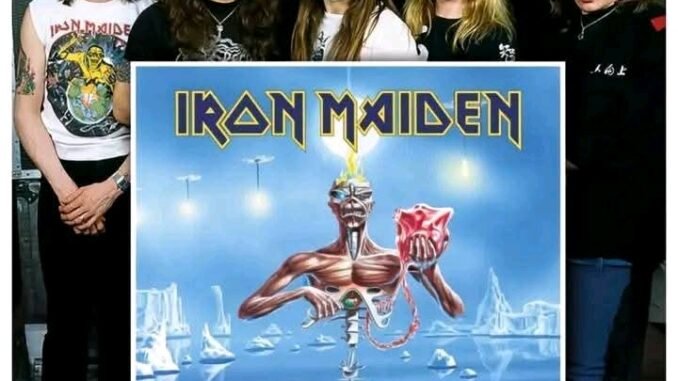
seventh son of a seventh son, iron maiden’s seventh studio album, released on 11 april 1988, debuted no.1 in uk, no.12 in us, spawning multiple top-charting singles worldwide.
Iron Maiden – Seventh Son of a Seventh Son: A Progressive Metal Milestone
On April 11, 1988, British heavy metal titans Iron Maiden released their seventh studio album, Seventh Son of a Seventh Son. Not only did the album mark a key moment in the band’s musical evolution, but it also stood as a bold venture into conceptual and progressive territory. The album debuted at No. 1 on the UK Albums Chart and climbed to No. 12 on the US Billboard 200, proving its global impact. Spawning several top-charting singles, the album remains a defining statement of Iron Maiden’s ambitious artistry during the late 1980s.The Concept: Myth, Magic, and Prophecy
At the heart of Seventh Son of a Seventh Son lies a conceptual narrative inspired by folklore and fantasy. The “seventh son of a seventh son” is a mythical figure believed in various cultures to possess supernatural powers—often seen as a healer or a prophet. Bassist and founding member Steve Harris, the band’s principal songwriter, conceived the idea after reading Orson Scott Card’s novel Seventh Son and exploring legends surrounding the mystical figure.
Unlike previous albums that featured standalone tracks, Seventh Son follows a loosely connected storyline about a gifted individual burdened by visions of the future and the moral conflicts of his powers. The narrative weaves themes of destiny, duality, good vs. evil, and personal torment—perfect fuel for Iron Maiden’s brand of theatrical, lyrical metal.A Progressive Turn
Musically, Seventh Son marked Iron Maiden’s most adventurous work to date. While the band had flirted with complex song structures before, this album took a bold step into progressive rock/metal, incorporating synthesizers more prominently and expanding their sound palette without abandoning the core Maiden energy.
Tracks like “Infinite Dreams”, “The Prophecy”, and “The Clairvoyant” demonstrate the band’s progressive leanings, featuring time signature shifts, layered guitars, melodic interludes, and extended instrumental passages. The use of guitar synths added atmospheric textures previously unexplored by the band. Though some fans were initially wary of the change in direction, many embraced it as a mature evolution of their sound.Track Highlights and Singles
The album spans eight tracks, each contributing to the overarching story while standing strong individually. Among them, several were released as singles and achieved considerable chart success:
“Can I Play with Madness” – Perhaps the most radio-friendly track, this song became a Top 3 UK hit and showcased Maiden’s ability to write catchy, melodic hard rock while retaining their metal roots. With a memorable chorus and a sharp video (featuring Monty Python’s Graham Chapman), it brought Iron Maiden to new audiences.“The Evil That Men Do” – A fan favorite, this single reached No. 5 in the UK and remains a staple in the band’s live set. Its anthemic chorus and dual guitar harmonies exemplify Maiden’s classic sound.“The Clairvoyant” – Charting in the UK Top 10, this track deals directly with the burden of foresight and fate. It begins with a haunting bass intro by Harris and builds into a dynamic metal epic.“Infinite Dreams” – While not as commercially successful as the other singles, this song is often praised for its introspective lyrics and progressive structure. It shifts from soft, dream-like verses into an explosive climax, mirroring the protagonist’s psychological conflict.
The title track, “Seventh Son of a Seventh Son”, is a nearly ten-minute opus that embodies the album’s grandeur. With complex arrangements, tempo shifts, and operatic ambition, it stands as a centerpiece of Iron Maiden’s progressive capabilities.Critical and Commercial Reception
Upon release, Seventh Son of a Seventh Son was met with critical acclaim and commercial success. In the UK, it immediately shot to No. 1, Iron Maiden’s second album to do so after The Number of the Beast. In the US, it reached No. 12, the band’s highest position at that time.
Critics praised the album’s scope, ambition, and execution. Many saw it as a culmination of Iron Maiden’s creative peak, combining the raw power of their earlier works with a newfound maturity in songwriting and thematic depth. Publications such as Kerrang! and Metal Hammer lauded it as a landmark in metal, and to this day, it’s frequently included in “best metal albums of all time” lists.
However, the move toward a more progressive sound also sparked some internal tension within the band. Guitarist Adrian Smith, a key contributor to the album’s songwriting and melodic direction, would leave the band after the subsequent tour, citing creative differences. He would not return until 1999.Legacy and Influence
Over three decades later, Seventh Son of a Seventh Son continues to resonate with fans and musicians alike. It represents a pivotal moment where Iron Maiden pushed the boundaries of traditional heavy metal, helping to shape what would later be known as progressive metal. Bands like Dream Theater, Opeth, and Symphony X cite this album as a foundational influence.
The tour that followed, Seventh Tour of a Seventh Tour, was one of Maiden’s most elaborate live spectacles to date, featuring elaborate stage sets, pyrotechnics, and the now-iconic ice-themed version of Eddie, their undead mascot.
In 2013, Iron Maiden revisited the album’s material during their Maiden England tour, reviving many songs from the Seventh Son era and reintroducing them to a new generation of fans.Conclusion
Seventh Son of a Seventh Son is more than just Iron Maiden’s seventh album—it’s a bold artistic statement that fused metal with narrative storytelling and progressive experimentation. It demonstrated that heavy metal could be both intellectually engaging and sonically powerful. With its enduring legacy, chart success, and creative ambition, the album remains a towering achievement in Iron Maiden’s storied career and a milestone in the history of heavy metal.
If you’d like a version formatted for a blog, magazine, or essay layout (with headers, bullets, or citations), I can do that too.
Leave a Reply